I first discovered Sara Larson Buscaglia of Farm & Folk through a photo of one of her quilts. I was so interested in her quilt-making process, and separately I have always been fascinated by the art of natural dyeing, so I was eager to learn more about how she combines the two to make heirloom-quality pieces of art.
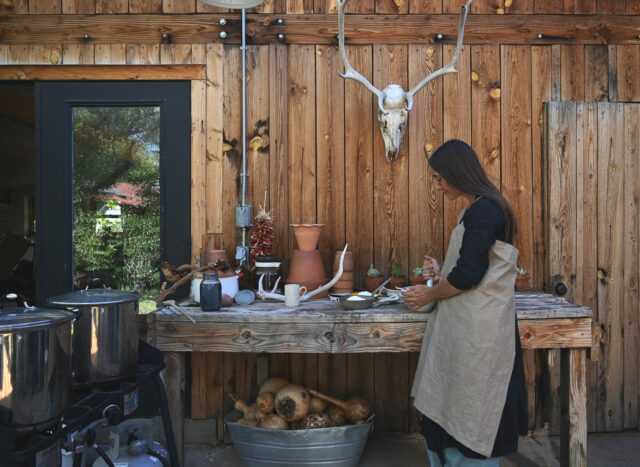 Sara has just written her first book, Farm & Folk Quilt Alchemy: A High-Country Guide to Natural Dyeing and Making Heirloom Quilts from Scratch, which introduces the processes of natural dyeing and quilting, and with its beautiful photography it is a piece of art in its own right.
Sara has just written her first book, Farm & Folk Quilt Alchemy: A High-Country Guide to Natural Dyeing and Making Heirloom Quilts from Scratch, which introduces the processes of natural dyeing and quilting, and with its beautiful photography it is a piece of art in its own right.
On her website, Sara says, “Farm & Folk is a fusion of my work as both an organic farmer and folk artist. The colors in my quilts are born through the alchemical processes of seeds + soil, sunlight, moonlight + water. Through this alchemy, the seeds are transformed to become fibers and dyestuffs, some of which are grown and harvested here on Ancient Future Farm. My fascination and passion for transferring natural color to natural fibers continues to grow stronger as the years roll by.” To me, this is pure magic!
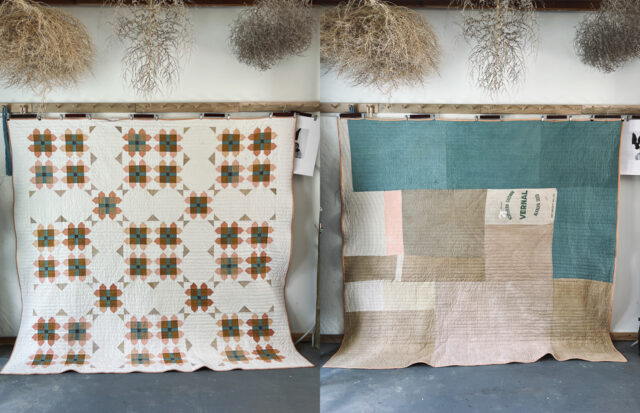 I was delighted when Sara agreed to create a commissioned quilt to help me commemorate filming season 2 of Growing Floret. I was so excited to collaborate with her using the pattern I had felt such a connection to, called the Folk Garden Quilt, and to incorporate flowers and colors from one of my much-loved paintings by Morgan Allender.
I was delighted when Sara agreed to create a commissioned quilt to help me commemorate filming season 2 of Growing Floret. I was so excited to collaborate with her using the pattern I had felt such a connection to, called the Folk Garden Quilt, and to incorporate flowers and colors from one of my much-loved paintings by Morgan Allender.
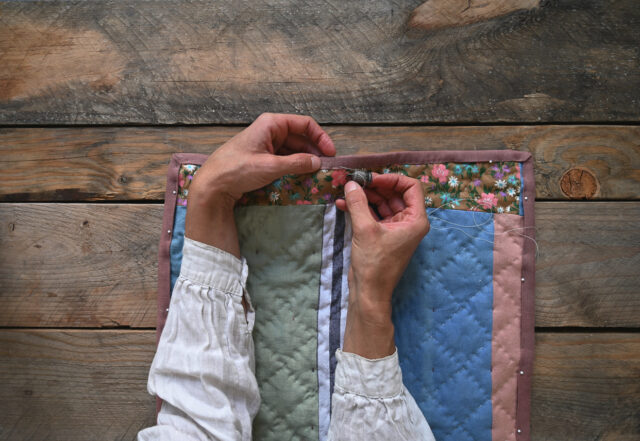 Sara’s timeless quilts are made using ethically and responsibly sourced materials, organically grown ingredients, and a slow and intentional process that authentically represents her values and her relationship with nature. She actually grows the flowers she uses to dye, she hand-dyes the fabric, and then every single stitch is made by her hands! There’s such an incredible amount of care in the entire process, and in the end you have a keepsake that will last many generations.
Sara’s timeless quilts are made using ethically and responsibly sourced materials, organically grown ingredients, and a slow and intentional process that authentically represents her values and her relationship with nature. She actually grows the flowers she uses to dye, she hand-dyes the fabric, and then every single stitch is made by her hands! There’s such an incredible amount of care in the entire process, and in the end you have a keepsake that will last many generations.
Sara is such a talented artist and an incredible photographer, and following her on Instagram is a must. Farm & Folk Quilt Alchemy will be released on September 26 and is available now for pre-order. I am thrilled to share it with you here today and hope you’ll be as inspired as I am.
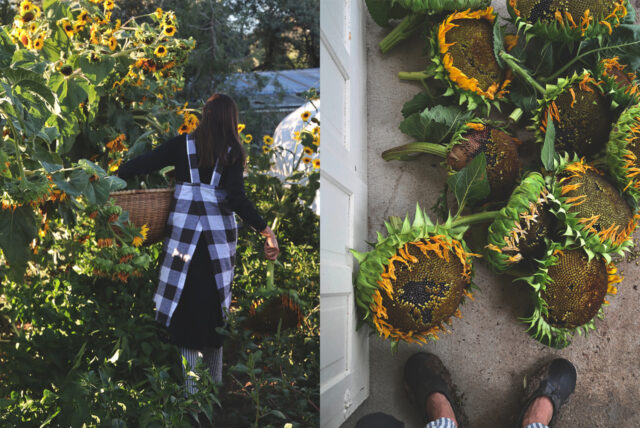 Sara, I’m so happy to welcome you to the blog. Please tell our readers a little bit about yourself and the evolution of your business, Farm & Folk.
Sara, I’m so happy to welcome you to the blog. Please tell our readers a little bit about yourself and the evolution of your business, Farm & Folk.
Thank you, Erin, I’m really grateful to be here! I’m an organic farmer, natural dyer, and folk artist rooted in the Colorado high desert. Farm & Folk began as a vision I had in 2015 to manifest a sustainable way in which I could balance my work as both a farmer and an artist—the two things that feed my soul. In autumn of 2017, I launched my website as a place to sell my naturally dyed, hand-stitched quilts and to share some blog posts about natural dyes and quilt making. I had the folk aspect of my work figured out, but wasn’t yet sure how I could weave in the farm aspect.
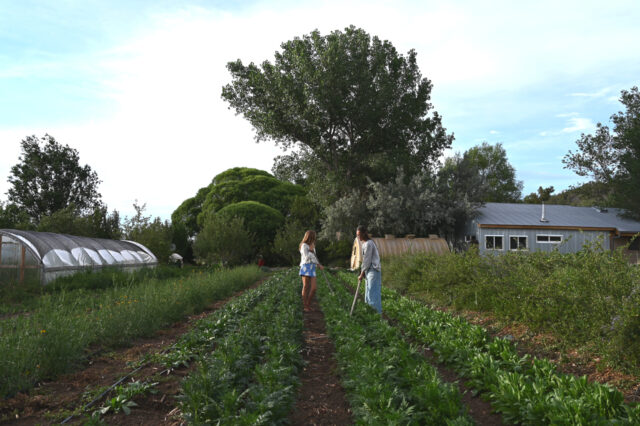 I made quilts very slowly in those first years, sometimes only two or three a year, between homeschooling my children and my work as a farmer. I was feeling creatively stifled at that time, like I might burst if I couldn’t find a way to make the art that was inside me. I knew I needed to prioritize quilts, so I began taking the steps that were required to evolve.
I made quilts very slowly in those first years, sometimes only two or three a year, between homeschooling my children and my work as a farmer. I was feeling creatively stifled at that time, like I might burst if I couldn’t find a way to make the art that was inside me. I knew I needed to prioritize quilts, so I began taking the steps that were required to evolve.
I began accepting the opportunities that came my way, including writing a book and taking on custom orders. Then, in winter of 2022, I had an epiphany that I should grow dye flowers as the farm aspect of my offerings. This created a way I could share my passion for transferring homegrown, natural color to fiber. I’m excited to see how this aspect of my work continues to unfurl.
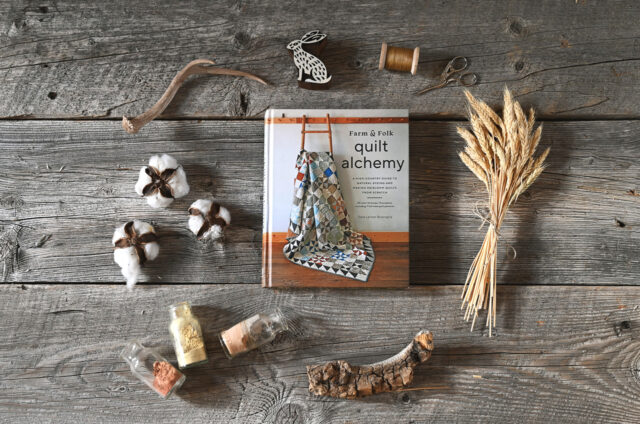 I am so excited about the release of your first book. This beautiful work pieces together the passions you’ve been pursuing for years: organic farming, natural dyeing, folk art, and quilting. What inspired you to write a book and what was that process like for you?
I am so excited about the release of your first book. This beautiful work pieces together the passions you’ve been pursuing for years: organic farming, natural dyeing, folk art, and quilting. What inspired you to write a book and what was that process like for you?
Thank you so much, Erin! My biggest inspiration for writing this book came from the hundreds of questions I’ve received from folks over the years about natural dyes and quilt making. A lot of people had the same questions, and I couldn’t keep answering them one by one. I started thinking about how I might answer them and it came down to a book. I love books! I’ve learned just about everything I know about farming and natural dyes and quilt making through books, so I wanted to give back in that way. I especially like that books are an accessible form of education.
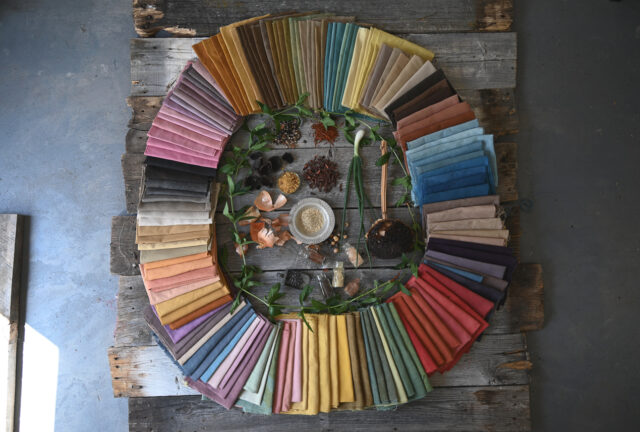 The process was a definite challenge for me! I put all my other work aside and spent 13 months focusing exclusively on the book. It’s really two books in one. The first half is all about natural dyes, with 20 color formulas specifically for cotton, linen, and hemp fabrics intended for quilt making. I spent 6 months testing my formulas and writing about my natural dye methods and processes.
The process was a definite challenge for me! I put all my other work aside and spent 13 months focusing exclusively on the book. It’s really two books in one. The first half is all about natural dyes, with 20 color formulas specifically for cotton, linen, and hemp fabrics intended for quilt making. I spent 6 months testing my formulas and writing about my natural dye methods and processes.
Then I spent 7 months writing the second half, which is all about making quilts. I put a lot of thought into the patterns and presented them in a skill-building fashion. I designed and made seven quilts in 6 months, which is so much for me, but the experience completely opened my eyes to what I was capable of.
It was a real hustle and a bit of a grind to finish the book in one year, but the irony was that it also completely forced me to stop and form words around not only how I do things, but why. I learned a lot about myself in that process.
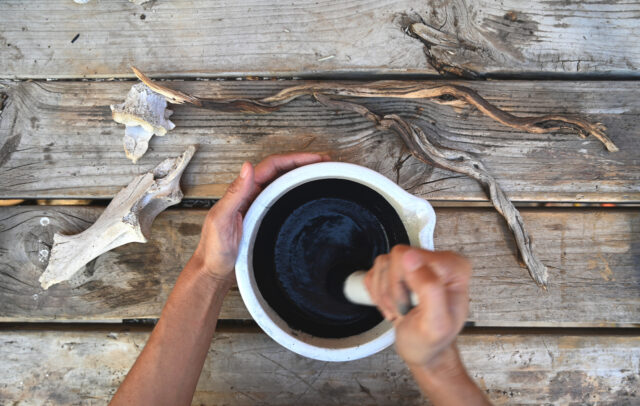 The book’s title is Farm & Folk Quilt Alchemy. Tell our readers why you chose the word alchemy and how it relates not only to the time-honored practices of farming and growing things, but also to the arts of natural dyeing and quilting.
The book’s title is Farm & Folk Quilt Alchemy. Tell our readers why you chose the word alchemy and how it relates not only to the time-honored practices of farming and growing things, but also to the arts of natural dyeing and quilting.
Alchemy means transformation. When I was pondering a title, the word alchemy felt like it was a good fit for all the sections. All the aspects of my work are transformative, from planting seeds that sprout to life from dark soil to transforming fibers with mordant and dyes to the transformation of cutting up dyed fabrics into hundreds of small pieces and sewing them back together again. They’re all such beautiful alchemical processes.
I like that the word alchemy makes folks stop and think, and that’s a big part of my intention for this book: to inspire folks to stop and think about some very basic things that have been a fundamental part of human existence since the beginning, like seeds and fiber and the art of making beautiful things with our hands.
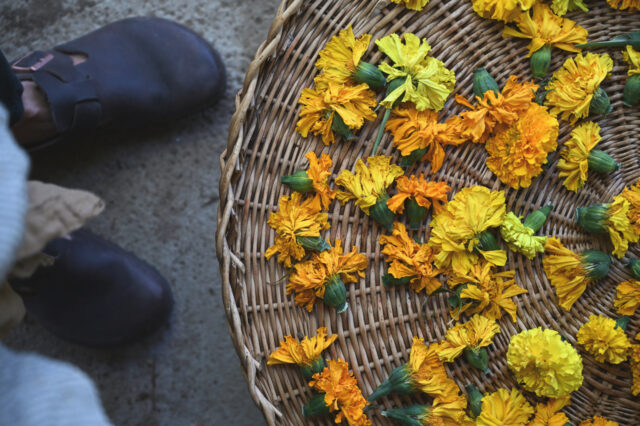 I have always been fascinated by the art of natural dyeing and growing flowers specifically for this purpose, but knowing where to begin can be intimidating. For someone completely new to this, how would you suggest they get started?
I have always been fascinated by the art of natural dyeing and growing flowers specifically for this purpose, but knowing where to begin can be intimidating. For someone completely new to this, how would you suggest they get started?
I have talked today about taking small steps that lead to big ones, but sometimes it’s best to just go ahead and dive in! When I first discovered natural dyes in 2002 at a workshop I attended at my son’s Waldorf preschool, I was enamored by the concept of plants as color! I came home from that workshop and immediately ordered the book Wild Colour by Jenny Dean. The internet wasn’t much of a thing back then, so I learned mostly through experimentation and trial and error.
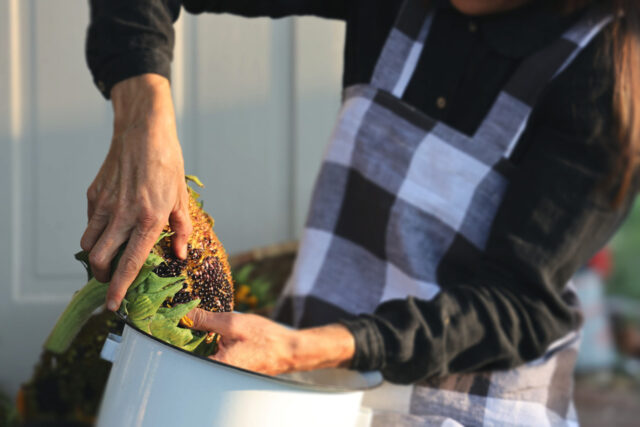 Then, when I planted my first big dye garden a couple years ago, I had never grown flowers before. I did a little bit of research about which flowers are good for dyes, I ordered the seeds, and when spring came along, I planted them. Once the seeds were planted, I was committed. I began harvesting them, which forced me to figure out how to dry and cure them. Then I began experimenting with them in the dye pots. I totally just figured everything out as I went.
Then, when I planted my first big dye garden a couple years ago, I had never grown flowers before. I did a little bit of research about which flowers are good for dyes, I ordered the seeds, and when spring came along, I planted them. Once the seeds were planted, I was committed. I began harvesting them, which forced me to figure out how to dry and cure them. Then I began experimenting with them in the dye pots. I totally just figured everything out as I went.
My best suggestion for someone trying anything completely new is to just go for it. Do some research, read some books, take a class or a workshop if you’re able—but just begin and problem-solve as you go. A lot of questions will come up, but you will find the answers because information is pretty easy to come by in this internet era. You will have some epic failures, but failures are what lead to epic successes. You don’t have to wait for the most perfect and ideal situation—just begin and revel in the experience of being an amateur. Just begin!
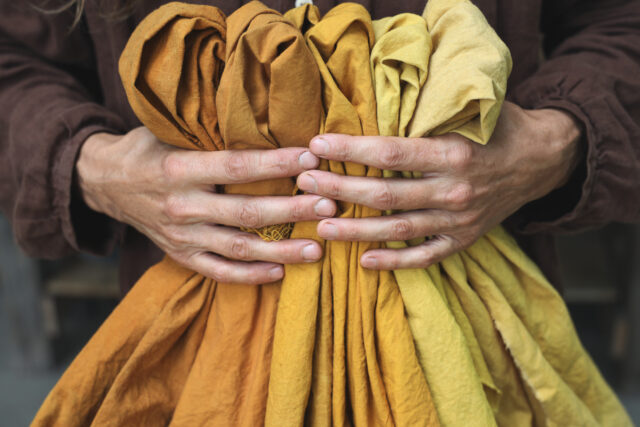 Creating natural dyes requires lots of experimentation, trial and error, failure, and trying again, all while knowing that we are working with nature and the end result may be out of our hands! How do you approach the process knowing that your hard work might not produce the outcome you’re hoping for?
Creating natural dyes requires lots of experimentation, trial and error, failure, and trying again, all while knowing that we are working with nature and the end result may be out of our hands! How do you approach the process knowing that your hard work might not produce the outcome you’re hoping for?
Being a farmer sure helps with this! The farm is the ultimate teacher of patience and perseverance. We’ve had crops decimated by hail, 10-year-old fruit trees eaten by goats, frost in the last week of June that takes out a whole crop. With natural dyes there are so many variables that can affect the outcome. It’s nearly impossible to produce the exact same color each and every time. This lack of control is actually appealing to me. It keeps me humble and forces me to let go of expectations and to see things from a different perspective. Besides beautiful, life-enriching colors, the soul medicines that natural dyes provide are acceptance and adaptability.
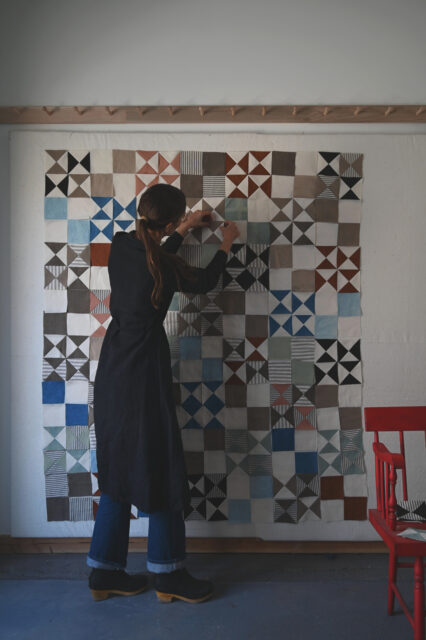 How did you fall in love with quilting and what is the inspiration for your designs? Do you plan out each quilt before you begin or do some evolve as you go?
How did you fall in love with quilting and what is the inspiration for your designs? Do you plan out each quilt before you begin or do some evolve as you go?
Quilting was something I always knew I would do, but I thought it would happen later in life. I began sewing when my first child was born. A decade later, my sewing scrap basket was overflowing with remnants of the fabrics I used to make clothes for my children over the years. The scraps felt too special to discard, so I made my first patchwork quilt with them. I instantly fell in love with quilt making and the ability it offered to express myself through shapes and pieces, colors and stitches, and I haven’t stopped yet.
Each next quilt still feels like an opportunity to expand off the previous one. My inspiration has always been traditional quilt blocks and designs, but more recently I’ve evolved into what I think of as traditional hybrid quilts. I enjoy adding modern aspects to traditional designs. I’ve also really been enjoying making appliqué-style story quilts as a way to tell the stories of my heart. Some quilts are planned before I begin, especially commissioned pieces, but others I figure out as I go along. Even when I have a plan, I often find that the plan will evolve as the piece comes together.
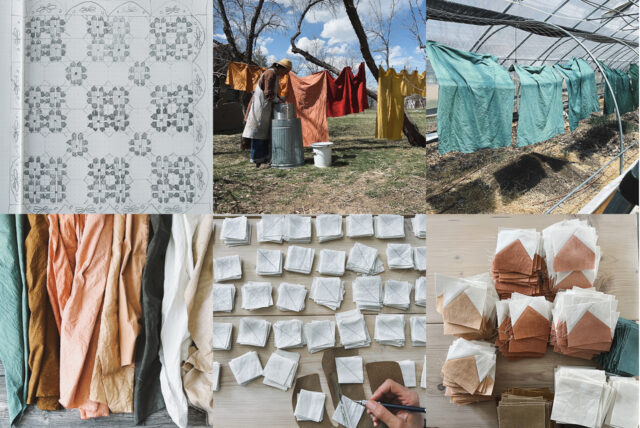
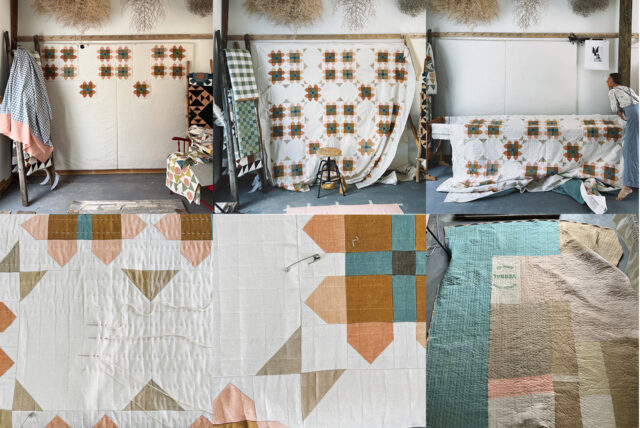 In addition to offering one-of-a-kind quilts on your website, you also take on a number of commissioned quilts each year. I was lucky enough to go through this process with you recently and it was so eye-opening. Would you take our readers through how a custom piece like mine comes to life?
In addition to offering one-of-a-kind quilts on your website, you also take on a number of commissioned quilts each year. I was lucky enough to go through this process with you recently and it was so eye-opening. Would you take our readers through how a custom piece like mine comes to life?
Yes! Commission pieces used to kind of freak me out. It’s a different process than just going to the studio and making something. The process is a collaboration of sorts, which is pretty sweet. It begins with an email inquiry. Sometimes folks know exactly what they want as far as colors, fibers, and design, and other times we have to go back and forth a great deal, honing in on the options. It takes about a month, give or take, for me to make a custom quilt, depending on the time of year. During the farming season it can take much longer! I send my clients regular progress updates and ask for feedback to ensure I’m staying on the right track as far as their vision for the piece. It’s always super exciting to make that last hand stitch and send the finished quilt out into the world.
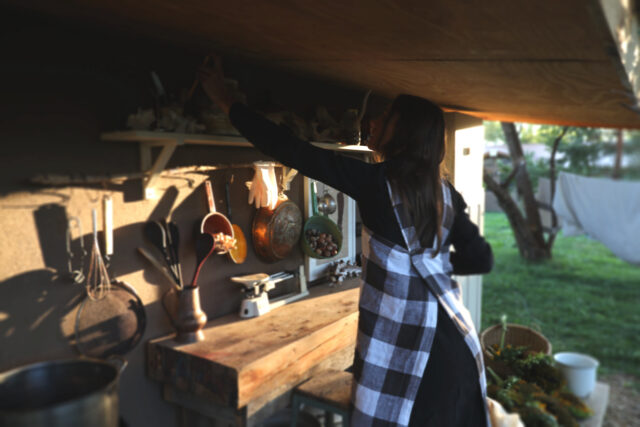 I know you’re planning to offer a few workshops this autumn and winter. Can you tell us more about those, and is there anything else in the works for you?
I know you’re planning to offer a few workshops this autumn and winter. Can you tell us more about those, and is there anything else in the works for you?
Workshops are a completely new offering and experience for me. Last month I traveled to New York to teach my first-ever workshop with my friend Katrina Rodabaugh at her home studio. I was pretty nervous about it, but I had so much fun and it was enriching to connect with Katrina, a fellow author/artist friend, and all the students. I’m teaching a natural dye workshop in Portland, Oregon, for the Portland Modern Quilt Guild in a few days. We will be dyeing a specific autumn-inspired palette and I’m looking forward to seeing how Portland’s alchemy translates the colors.
Then in October I’m teaching a fleece-spinning and natural dye workshop with my friend Stella Maria Baer of Moon Horse Ranch in Santa Fe, New Mexico. I began my adventures in fiber arts by spinning wool from my sheep, so I’m really excited to get back to my roots and share this passion with others. There are still tickets available for that one, so please join us for what is sure to be an auspicious solar eclipse fiber weekend in the October desert!
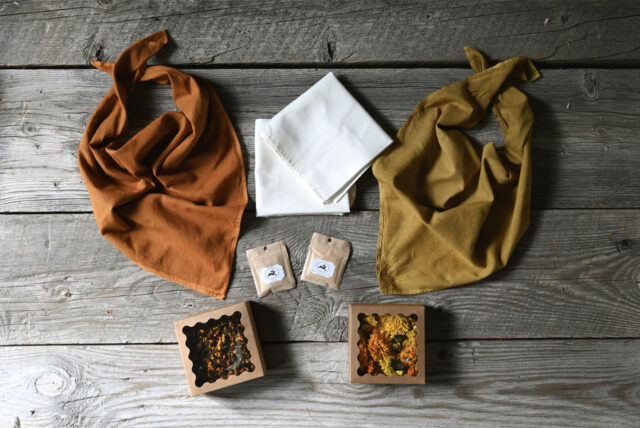 As far as what’s in the works, I will be offering two dye flower kits in my online shop the first week of October. The first is a beginner dye kit for folks who want to try natural dyeing for the first time. It comes with two organic cotton bandanas from my friends at Maiwa, two of my homegrown organic dye flower varieties, and all the other supplies needed, along with a booklet containing detailed instructions.
As far as what’s in the works, I will be offering two dye flower kits in my online shop the first week of October. The first is a beginner dye kit for folks who want to try natural dyeing for the first time. It comes with two organic cotton bandanas from my friends at Maiwa, two of my homegrown organic dye flower varieties, and all the other supplies needed, along with a booklet containing detailed instructions.
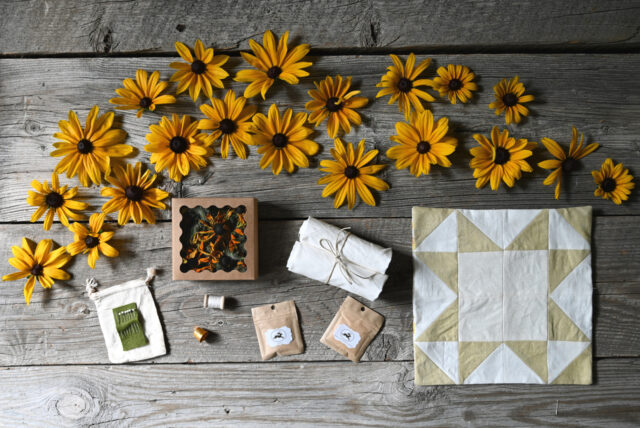 The other kit combines natural dyeing and quilting. It comes with one pack of dye flowers and all the other supplies needed to make a plant-dyed quilt block, including needles and thread and a thimble for folks who don’t have a sewing machine. The detailed instructional booklet explains how to make a star block design. The single quilt block can be sewn onto the back of a jacket or shirt, and I’ve created a blog post to explain that. I love putting these kits out into the world and seeing folks get excited to try something new and then to see them feel proud of what they made. It’s so special!
The other kit combines natural dyeing and quilting. It comes with one pack of dye flowers and all the other supplies needed to make a plant-dyed quilt block, including needles and thread and a thimble for folks who don’t have a sewing machine. The detailed instructional booklet explains how to make a star block design. The single quilt block can be sewn onto the back of a jacket or shirt, and I’ve created a blog post to explain that. I love putting these kits out into the world and seeing folks get excited to try something new and then to see them feel proud of what they made. It’s so special!
For a couple years I’ve been contemplating a late-summer workshop on my farm when all the dye plants are in bloom. The vegetable gardens would be in full production as well, so we could eat off the land. Perhaps it’s time to make that vision happen!
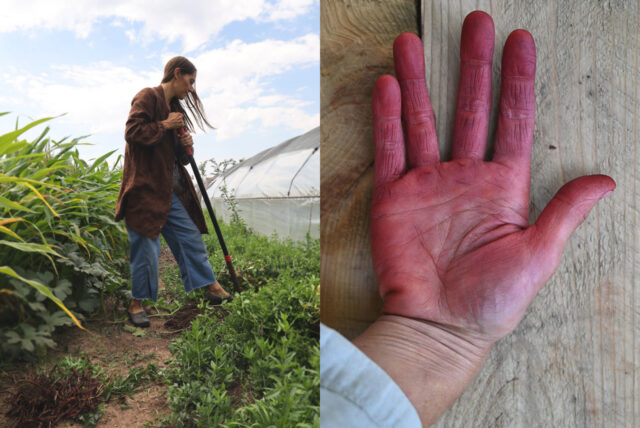 I love that you have come to where you are by following your heart and living gently. What advice would you give to others who are trying to shift to a more intentional and regenerative lifestyle?
I love that you have come to where you are by following your heart and living gently. What advice would you give to others who are trying to shift to a more intentional and regenerative lifestyle?
I was born with a stubborn gene, which has made following my heart rather easy. My husband Tom and I became farmers because we fell in love with the magic that is seeds and soil, but the actual catalyst was that we unequivocally did not want to spend our lives working any semblance of what we thought of as mainstream careers. When we planted our first garden, we had no idea what we were doing. We both grew up in midwestern suburbs, with no exposure to agricultural ways.
Gardening became our passion, which we turned into our livelihood. As the years and decades pass, we have never been afraid to evolve when things feel like they’re weighing us down. The weight of something that isn’t feeding our souls feels a lot heavier to us than taking the risky leaps of faith that are required to evolve.
We basically unintentionally ended up living an intentional regenerative lifestyle. It all unfolded organically and with a lot of grit and hard work as we forged our way to each next step. Everyone’s situation is going to be different, but the best advice I can offer is don’t be afraid to evolve when your heart is telling you it’s time. This will require making a lot of sacrifices.
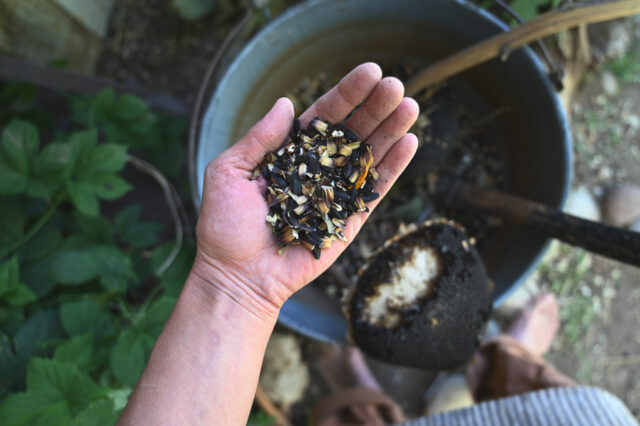 Set a goal and then begin taking steps, no matter how small they may seem. Small steps over time become big steps. If your goal is something completely new and different to you, remember that every single person who has become great at something began as an amateur. It takes years of focus and dedication, triumphs and defeats, to become skilled at something.
Set a goal and then begin taking steps, no matter how small they may seem. Small steps over time become big steps. If your goal is something completely new and different to you, remember that every single person who has become great at something began as an amateur. It takes years of focus and dedication, triumphs and defeats, to become skilled at something.
Prioritizing what makes you happy and letting go of the things that are not serving your soul is revolutionary not only on a personal level, but on a collective level. If we can work toward collectively following our hearts, then the outcome will reshape the world—and the world desperately needs reshaping.
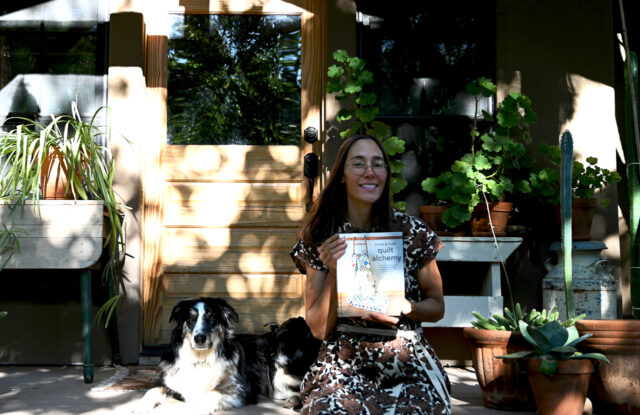 Sara, thank you so much for sharing your business and your beautiful new book with our readers here today. I know the book is going to be such an inspiration to people who would like to try working with natural dyes or creating handmade heirloom pieces of their own.
Sara, thank you so much for sharing your business and your beautiful new book with our readers here today. I know the book is going to be such an inspiration to people who would like to try working with natural dyes or creating handmade heirloom pieces of their own.
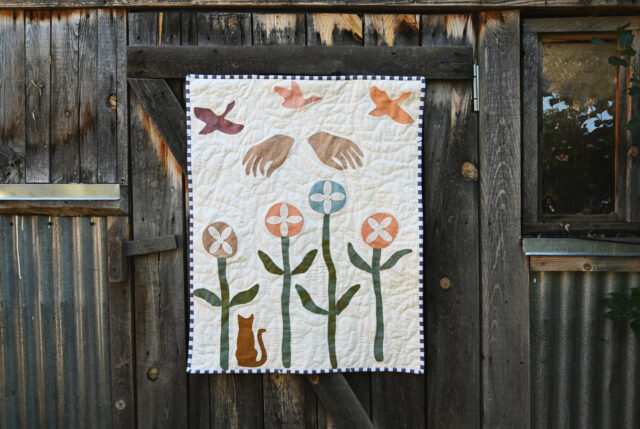 To celebrate the release of Sara’s new book, Farm & Folk Quilt Alchemy: A High-Country Guide to Natural Dyeing and Making Heirloom Quilts from Scratch, we’re giving away four copies, plus one lucky reader will win a copy of the book and a handmade wall hanging that matches my own quilt! For a chance to win, simply post a comment below telling us about a cherished heirloom from your own family. Winners will be announced on September 26.
To celebrate the release of Sara’s new book, Farm & Folk Quilt Alchemy: A High-Country Guide to Natural Dyeing and Making Heirloom Quilts from Scratch, we’re giving away four copies, plus one lucky reader will win a copy of the book and a handmade wall hanging that matches my own quilt! For a chance to win, simply post a comment below telling us about a cherished heirloom from your own family. Winners will be announced on September 26.
A huge congratulations to our winners: Juliana, Keren Tsaushu, Lisandre St-Cyr Lamothe, Claudia Casebolt and Damita Becknell.
To learn more and connect with Sara, be sure to visit her website to sign up for her newsletter and follow her on Instagram. Farm & Folk Quilt Alchemy is available from Amazon, Bookshop, Barnes & Noble, and your favorite local bookstore.
Please note: If your comment doesn’t show up right away, sit tight; we have a spam filter that requires us to approve comments before they are published.
Floret only lists companies and products that we love, use, and recommend. All opinions expressed here are our own and Floret does not offer sponsored content or accept money for editorial reviews. If you buy something using the retail links in this post, Floret may receive a small commission. Thank you for your support!
The post The {Farmer} & The Florist Interview: Sara Larson Buscaglia appeared first on Floret Flowers.

On her website, Sara says, “Farm & Folk is a fusion of my work as both an organic farmer and folk artist. The colors in my quilts are born through the alchemical processes of seeds + soil, sunlight, moonlight + water. Through this alchemy, the seeds are transformed to become fibers and dyestuffs, some of which are grown and harvested here on Ancient Future Farm. My fascination and passion for transferring natural color to natural fibers continues to grow stronger as the years roll by.” To me, this is pure magic!


Sara is such a talented artist and an incredible photographer, and following her on Instagram is a must. Farm & Folk Quilt Alchemy will be released on September 26 and is available now for pre-order. I am thrilled to share it with you here today and hope you’ll be as inspired as I am.

Thank you, Erin, I’m really grateful to be here! I’m an organic farmer, natural dyer, and folk artist rooted in the Colorado high desert. Farm & Folk began as a vision I had in 2015 to manifest a sustainable way in which I could balance my work as both a farmer and an artist—the two things that feed my soul. In autumn of 2017, I launched my website as a place to sell my naturally dyed, hand-stitched quilts and to share some blog posts about natural dyes and quilt making. I had the folk aspect of my work figured out, but wasn’t yet sure how I could weave in the farm aspect.

I began accepting the opportunities that came my way, including writing a book and taking on custom orders. Then, in winter of 2022, I had an epiphany that I should grow dye flowers as the farm aspect of my offerings. This created a way I could share my passion for transferring homegrown, natural color to fiber. I’m excited to see how this aspect of my work continues to unfurl.

Thank you so much, Erin! My biggest inspiration for writing this book came from the hundreds of questions I’ve received from folks over the years about natural dyes and quilt making. A lot of people had the same questions, and I couldn’t keep answering them one by one. I started thinking about how I might answer them and it came down to a book. I love books! I’ve learned just about everything I know about farming and natural dyes and quilt making through books, so I wanted to give back in that way. I especially like that books are an accessible form of education.

Then I spent 7 months writing the second half, which is all about making quilts. I put a lot of thought into the patterns and presented them in a skill-building fashion. I designed and made seven quilts in 6 months, which is so much for me, but the experience completely opened my eyes to what I was capable of.
It was a real hustle and a bit of a grind to finish the book in one year, but the irony was that it also completely forced me to stop and form words around not only how I do things, but why. I learned a lot about myself in that process.

Alchemy means transformation. When I was pondering a title, the word alchemy felt like it was a good fit for all the sections. All the aspects of my work are transformative, from planting seeds that sprout to life from dark soil to transforming fibers with mordant and dyes to the transformation of cutting up dyed fabrics into hundreds of small pieces and sewing them back together again. They’re all such beautiful alchemical processes.
I like that the word alchemy makes folks stop and think, and that’s a big part of my intention for this book: to inspire folks to stop and think about some very basic things that have been a fundamental part of human existence since the beginning, like seeds and fiber and the art of making beautiful things with our hands.

I have talked today about taking small steps that lead to big ones, but sometimes it’s best to just go ahead and dive in! When I first discovered natural dyes in 2002 at a workshop I attended at my son’s Waldorf preschool, I was enamored by the concept of plants as color! I came home from that workshop and immediately ordered the book Wild Colour by Jenny Dean. The internet wasn’t much of a thing back then, so I learned mostly through experimentation and trial and error.

My best suggestion for someone trying anything completely new is to just go for it. Do some research, read some books, take a class or a workshop if you’re able—but just begin and problem-solve as you go. A lot of questions will come up, but you will find the answers because information is pretty easy to come by in this internet era. You will have some epic failures, but failures are what lead to epic successes. You don’t have to wait for the most perfect and ideal situation—just begin and revel in the experience of being an amateur. Just begin!

Being a farmer sure helps with this! The farm is the ultimate teacher of patience and perseverance. We’ve had crops decimated by hail, 10-year-old fruit trees eaten by goats, frost in the last week of June that takes out a whole crop. With natural dyes there are so many variables that can affect the outcome. It’s nearly impossible to produce the exact same color each and every time. This lack of control is actually appealing to me. It keeps me humble and forces me to let go of expectations and to see things from a different perspective. Besides beautiful, life-enriching colors, the soul medicines that natural dyes provide are acceptance and adaptability.

Quilting was something I always knew I would do, but I thought it would happen later in life. I began sewing when my first child was born. A decade later, my sewing scrap basket was overflowing with remnants of the fabrics I used to make clothes for my children over the years. The scraps felt too special to discard, so I made my first patchwork quilt with them. I instantly fell in love with quilt making and the ability it offered to express myself through shapes and pieces, colors and stitches, and I haven’t stopped yet.
Each next quilt still feels like an opportunity to expand off the previous one. My inspiration has always been traditional quilt blocks and designs, but more recently I’ve evolved into what I think of as traditional hybrid quilts. I enjoy adding modern aspects to traditional designs. I’ve also really been enjoying making appliqué-style story quilts as a way to tell the stories of my heart. Some quilts are planned before I begin, especially commissioned pieces, but others I figure out as I go along. Even when I have a plan, I often find that the plan will evolve as the piece comes together.


Yes! Commission pieces used to kind of freak me out. It’s a different process than just going to the studio and making something. The process is a collaboration of sorts, which is pretty sweet. It begins with an email inquiry. Sometimes folks know exactly what they want as far as colors, fibers, and design, and other times we have to go back and forth a great deal, honing in on the options. It takes about a month, give or take, for me to make a custom quilt, depending on the time of year. During the farming season it can take much longer! I send my clients regular progress updates and ask for feedback to ensure I’m staying on the right track as far as their vision for the piece. It’s always super exciting to make that last hand stitch and send the finished quilt out into the world.

Workshops are a completely new offering and experience for me. Last month I traveled to New York to teach my first-ever workshop with my friend Katrina Rodabaugh at her home studio. I was pretty nervous about it, but I had so much fun and it was enriching to connect with Katrina, a fellow author/artist friend, and all the students. I’m teaching a natural dye workshop in Portland, Oregon, for the Portland Modern Quilt Guild in a few days. We will be dyeing a specific autumn-inspired palette and I’m looking forward to seeing how Portland’s alchemy translates the colors.
Then in October I’m teaching a fleece-spinning and natural dye workshop with my friend Stella Maria Baer of Moon Horse Ranch in Santa Fe, New Mexico. I began my adventures in fiber arts by spinning wool from my sheep, so I’m really excited to get back to my roots and share this passion with others. There are still tickets available for that one, so please join us for what is sure to be an auspicious solar eclipse fiber weekend in the October desert!


For a couple years I’ve been contemplating a late-summer workshop on my farm when all the dye plants are in bloom. The vegetable gardens would be in full production as well, so we could eat off the land. Perhaps it’s time to make that vision happen!

I was born with a stubborn gene, which has made following my heart rather easy. My husband Tom and I became farmers because we fell in love with the magic that is seeds and soil, but the actual catalyst was that we unequivocally did not want to spend our lives working any semblance of what we thought of as mainstream careers. When we planted our first garden, we had no idea what we were doing. We both grew up in midwestern suburbs, with no exposure to agricultural ways.
Gardening became our passion, which we turned into our livelihood. As the years and decades pass, we have never been afraid to evolve when things feel like they’re weighing us down. The weight of something that isn’t feeding our souls feels a lot heavier to us than taking the risky leaps of faith that are required to evolve.
We basically unintentionally ended up living an intentional regenerative lifestyle. It all unfolded organically and with a lot of grit and hard work as we forged our way to each next step. Everyone’s situation is going to be different, but the best advice I can offer is don’t be afraid to evolve when your heart is telling you it’s time. This will require making a lot of sacrifices.

Prioritizing what makes you happy and letting go of the things that are not serving your soul is revolutionary not only on a personal level, but on a collective level. If we can work toward collectively following our hearts, then the outcome will reshape the world—and the world desperately needs reshaping.


A huge congratulations to our winners: Juliana, Keren Tsaushu, Lisandre St-Cyr Lamothe, Claudia Casebolt and Damita Becknell.
To learn more and connect with Sara, be sure to visit her website to sign up for her newsletter and follow her on Instagram. Farm & Folk Quilt Alchemy is available from Amazon, Bookshop, Barnes & Noble, and your favorite local bookstore.
Please note: If your comment doesn’t show up right away, sit tight; we have a spam filter that requires us to approve comments before they are published.
Floret only lists companies and products that we love, use, and recommend. All opinions expressed here are our own and Floret does not offer sponsored content or accept money for editorial reviews. If you buy something using the retail links in this post, Floret may receive a small commission. Thank you for your support!
The post The {Farmer} & The Florist Interview: Sara Larson Buscaglia appeared first on Floret Flowers.
